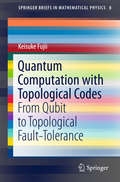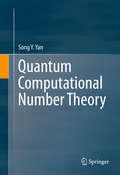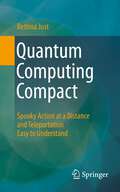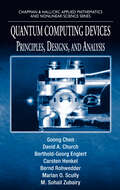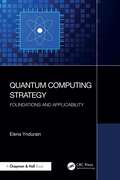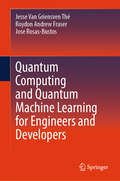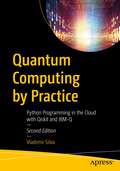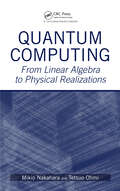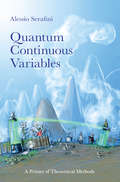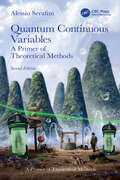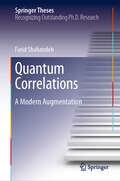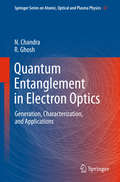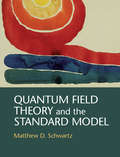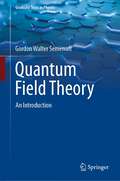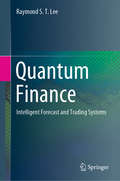- Table View
- List View
Quantum Computation with Topological Codes
by Keisuke FujiiThis book presents a self-consistent review of quantum computation with topological quantum codes. The book covers everything required to understand topological fault-tolerant quantum computation, ranging from the definition of the surface code to topological quantum error correction and topological fault-tolerant operations. The underlying basic concepts and powerful tools, such as universal quantum computation, quantum algorithms, stabilizer formalism, and measurement-based quantum computation, are also introduced in a self-consistent way. The interdisciplinary fields between quantum information and other fields of physics such as condensed matter physics and statistical physics are also explored in terms of the topological quantum codes. This book thus provides the first comprehensive description of the whole picture of topological quantum codes and quantum computation with them.
Quantum Computational Number Theory
by Song Y. YanThis book provides a comprehensive introduction to advanced topics in the computational and algorithmic aspects of number theory, focusing on applications in cryptography. Readers will learn to develop fast algorithms, including quantum algorithms, to solve various classic and modern number theoretic problems. Key problems include prime number generation, primality testing, integer factorization, discrete logarithms, elliptic curve arithmetic, conjecture and numerical verification. The author discusses quantum algorithms for solving the Integer Factorization Problem (IFP), the Discrete Logarithm Problem (DLP), and the Elliptic Curve Discrete Logarithm Problem (ECDLP) and for attacking IFP, DLP and ECDLP based cryptographic systems. Chapters also cover various other quantum algorithms for Pell's equation, principal ideal, unit group, class group, Gauss sums, prime counting function, Riemann's hypothesis and the BSD conjecture. Quantum Computational Number Theory is self-contained and intended to be used either as a graduate text in computing, communications and mathematics, or as a basic reference in the related fields. Number theorists, cryptographers and professionals working in quantum computing, cryptography and network security will find this book a valuable asset.
Quantum Computing Compact: Spooky Action at a Distance and Teleportation Easy to Understand
by Bettina JustWhat is the phenomenon of quantum entanglement? If you read popular science literature, there is talk of socks that are red and blue at the same time, but monochromatic - how is that supposed to work? If you read scientific literature, you have to have knowledge of functional analysis.This book vividly builds the bridge between the experiments that led to quantum entanglement and the algorithm for teleportation, assuming only an elementary knowledge of mathematics.
Quantum Computing Devices: Principles, Designs, and Analysis
by Goong Chen David A. Church Berthold-Georg Englert Carsten Henkel Bernd Rohwedder Marlan O. Scully M. Suhail ZubairyOne of the first books to thoroughly examine the subject, Quantum Computing Devices: Principles, Designs, and Analysis covers the essential components in the design of a "real" quantum computer. It explores contemporary and important aspects of quantum computation, particularly focusing on the role of quantum electronic devices as quantum gates.
Quantum Computing Strategy: Foundations and Applicability
by Elena YndurainQuantum computing is not merely an incremental advancement in computing technology; it represents a fundamentally new paradigm, distinct from classical computing. Rooted in quantum mechanics, it introduces an entirely novel information theory. As a result, translating existing models, solution designs, and approaches to quantum computing is a complex, non-trivial task. This comprehensive book demystifies quantum concepts through accessible explanations, practical case studies, and real-world examples from industries such as aerospace, agriculture, automotive, chemicals, energy, finance, government, healthcare, manufacturing, supply chain, and telecommunications.Blending a business perspective with a scientific rigor, this book is divided into two parts. The first part covers foundational technical concepts, including quantum mechanics principles that enable quantum technologies, key quantum algorithms, mathematical frameworks, quantum computing technologies, post-quantum cryptography, the types of problems quantum computers solve, and the technology’s outlook. The second part focuses on practical applicability, presenting industry use cases, guidance on approaching quantum computing problems, mapping use cases to quantum computing, responsible quantum computing practices, and a roadmap for businesses preparing for quantum adoption. This structured approach equips readers with the knowledge and tools to effectively integrate quantum computing into their strategic planning.Quantum Computing Strategy: Foundations and Applicability serves as an essential reference for technology enthusiasts, business leaders, policymakers, and educators seeking to understand the benefits quantum computing offers enterprises. Designed as a self-contained learning resource, it empowers readers to navigate the emerging quantum landscape confidently.
Quantum Computing and Quantum Machine Learning for Engineers and Developers
by Jesse Van Griensven Thé Roydon Andrew Fraser Jose Rosas-BustosThis book guides readers from the foundations of quantum mechanics through advanced quantum algorithms (such as Shor&’s and Grover&’s) and state-of-the-art machine learning methods. By illustrating how these concepts apply to everyday engineering challenges, ranging from complex optimization and cryptography to high-fidelity simulations, the authors equip readers with the tools they need to develop and deploy quantum-based solutions. Incorporating practical case studies, industry-standard platforms, and tested pedagogical approaches, this resource speaks to both academic researchers and industry professionals, enabling them to seamlessly integrate quantum technologies into their projects and workflow
Quantum Computing by Practice: Python Programming in the Cloud with Qiskit and IBM-Q
by Vladimir SilvaLearn to write algorithms and program in the new field of quantum computing. This second edition is updated to equip you with the latest knowledge and tools needed to be a complex problem-solver in this ever-evolving landscape. The book has expanded its coverage of current and future advancements and investments by IT companies in this emerging technology. Most chapters are thoroughly revised to incorporate the latest updates to IBM Quantum's systems and offerings, such as improved algorithms, integrating hardware advancements, software enhancements, bug fixes, and more. You’ll examine quantum computing in the cloud and run experiments there on a real quantum device. Along the way you’ll cover game theory with the Magic Square, an example of quantum pseudo-telepathy. You’ll also learn to write code using QISKit, Python SDK, and other APIs such as QASM and execute it against simulators (local or remote) or a real quantum computer. Then peek inside the inner workings of the Bell states for entanglement, Grover’s algorithm for linear search, Shor’s algorithm for integer factorization, and other algorithms in the fields of optimization, and more. Finally, you’ll learn the current quantum algorithms for entanglement, random number generation, linear search, integer factorization, and others. By the end of this book, you’ll understand how quantum computing provides massive parallelism and significant computational speedups over classical computersWhat You'll LearnWrite algorithms that provide superior performance over their classical counterpartsCreate a quantum number generator: the quintessential coin flip with a quantum twistExamine the quantum algorithms in use today for random number generation, linear search, and moreDiscover quantum teleportationHandle the counterfeit coin problem, a classic puzzle Put your knowledge to the test with more than 150 practice exercises Who This Book Is ForDevelopers, programmers, computer science researchers, teachers, and students.
Quantum Computing: Applications and Challenges (Information Systems Engineering and Management #2)
by Farouk Yalaoui Habiba DriasThis book is intended for academics, researchers, Ph.D. students, and industrials to learn about quantum computing and prepare them to understand the future with its cutting-edge tools. Quantum computing holds great promise in terms of human life quality especially when combined with artificial intelligence. In addition to quantum computing, the book focuses on quantum artificial intelligence, quantum machine and deep learning, quantum cryptography, and quantum logistics optimization. Applications in weather forecasting, digital soil mapping, skin lesion classification, combinatorial optimization, and urgent transportation, among others, are presented.
Quantum Computing: From Linear Algebra to Physical Realizations
by Mikio Nakahara Tetsuo OhmiCovering both theory and progressive experiments, Quantum Computing: From Linear Algebra to Physical Realizations explains how and why superposition and entanglement provide the enormous computational power in quantum computing. This self-contained, classroom-tested book is divided into two sections, with the first devoted to the theoretical aspect
Quantum Concepts in the Social, Ecological and Biological Sciences
by Fabio BagarelloQuantum mechanics is traditionally associated with microscopic systems; however, quantum concepts have also been successfully applied to a diverse range of macroscopic systems both within and outside of physics. This book describes how complex systems from a variety of fields can be modelled using quantum mechanical principles; from biology and ecology, to sociology and decision-making. The mathematical basis of these models is covered in detail, furnishing a self-contained and consistent approach. This book provides unique insight into the dynamics of these macroscopic systems and opens new interdisciplinary research frontiers. It will be an essential resource for students and researchers in applied mathematics or theoretical physics who are interested in applying quantum mechanics to dynamical systems in the social, biological or ecological sciences.
Quantum Continuous Variables: A Primer of Theoretical Methods
by Alessio SerafiniQuantum Continuous Variables introduces the theory of continuous variable quantum systems, from its foundations based on the framework of Gaussian states to modern developments, including its applications to quantum information and forthcoming quantum technologies. This new book addresses the theory of Gaussian states, operations, and dynamics in great depth and breadth, through a novel approach that embraces both the Hilbert space and phase descriptions. The volume includes coverage of entanglement theory and quantum information protocols, and their connection with relevant experimental set-ups. General techniques for non-Gaussian manipulations also emerge as the treatment unfolds, and are demonstrated with specific case studies. This book will be of interest to graduate students looking to familiarise themselves with the field, in addition to experienced researchers eager to enhance their understanding of its theoretical methods. It will also appeal to experimentalists searching for a rigorous but accessible treatment of the theory in the area.
Quantum Continuous Variables: A Primer of Theoretical Methods
by Alessio SerafiniQuantum Continuous Variables introduces the theory of continuous variable quantum systems, from its foundations based on the framework of Gaussian states to modern developments, including its applications to quantum information and forthcoming quantum technologies. This book addresses the theory of Gaussian states, operations, and dynamics in great depth and breadth, through a novel approach that embraces both the Hilbert space and phase descriptions.The second edition of this book has been revised throughout, and updated to include new topics, such as boson sampling, coherent feedback, nonlinear control, as well as several new solved problems.The volume includes coverage of entanglement theory and quantum information protocols, and their connection with relevant experimental set-ups. General techniques for non-Gaussian manipulations also emerge as the treatment unfolds and are demonstrated with specific case studies.This book will be of interest to graduate students looking to familiarise themselves with the field, in addition to experienced researchers eager to enhance their understanding of its theoretical methods. It will also appeal to experimentalists searching for a rigorous but accessible treatment of the theory in the area.Features Provides the first systematic graduate-level textbook for the field of quantum continuous variables and includes 77 problems for the reader, with accompanying solutions Explores applications to entanglement theory, nonlocality, quantum technologies and quantum control Describes, in detail, a comprehensive list of experimental platforms where the formalism applies Alessio Serafini earned his PhD from the University of Salerno. He is currently a Professor at University College London. His research focuses mainly on quantum optics, quantum information with continuous variables, and the theory of quantum control.
Quantum Correlations: A Modern Augmentation (Springer Theses)
by Farid ShahandehThe correlations between physical systems provide significant information about their collective behaviour – information that is used as a resource in many applications, e.g. communication protocols. However, when it comes to the exploitation of such correlations in the quantum world, identification of the associated ‘resource’ is extremely challenging and a matter of debate in the quantum community. This dissertation describes three key results on the identification, detection, and quantification of quantum correlations. It starts with an extensive and accessible introduction to the mathematical and physical grounds for the various definitions of quantum correlations. It subsequently focusses on introducing a novel unified picture of quantum correlations by taking a modern resource-theoretic position. The results show that this novel concept plays a crucial role in the performance of collaborative quantum computations that is not captured by the standard textbook approaches. Further, this new perspective provides a deeper understanding of the quantum-classical boundary and paves the way towards establishing a resource theory of quantum computations.
Quantum Dynamics for Classical Systems: With Applications of the Number Operator
by Fabio BagarelloIntroduces number operators with a focus on the relationship between quantum mechanics and social science Mathematics is increasingly applied to classical problems in finance, biology, economics, and elsewhere. Quantum Dynamics for Classical Systems describes how quantum tools—the number operator in particular—can be used to create dynamical systems in which the variables are operator-valued functions and whose results explain the presented model. The book presents mathematical results and their applications to concrete systems and discusses the methods used, results obtained, and techniques developed for the proofs of the results. The central ideas of number operators are illuminated while avoiding excessive technicalities that are unnecessary for understanding and learning the various mathematical applications. The presented dynamical systems address a variety of contexts and offer clear analyses and explanations of concluded results. Additional features in Quantum Dynamics for Classical Systems include: Applications across diverse fields including stock markets and population migration as well as a unique quantum perspective on these classes of models Illustrations of the use of creation and annihilation operators for classical problems Examples of the recent increase in research and literature on the many applications of quantum tools in applied mathematics Clarification on numerous misunderstandings and misnomers while shedding light on new approaches in the field Quantum Dynamics for Classical Systems is an ideal reference for researchers, professionals, and academics in applied mathematics, economics, physics, biology, and sociology. The book is also excellent for courses in dynamical systems, quantum mechanics, and mathematical models.
Quantum Entanglement in Electron Optics
by Rama Ghosh Naresh ChandraThis monograph forms an interdisciplinary study in atomic, molecular, and quantum information (QI) science. Here a reader will find that applications of the tools developed in QI provide new physical insights into electron optics as well as properties of atoms & molecules which, in turn, are useful in studying QI both at fundamental and applied levels. In particular, this book investigates entanglement properties of flying electronic qubits generated in some of the well known processes capable of taking place in an atom or a molecule following the absorption of a photon. Here, one can generate Coulombic or fine-structure entanglement of electronic qubits. The properties of these entanglements differ not only from each other, but also from those when spin of an inner-shell photoelectron is entangled with the polarization of the subsequent fluorescence. Spins of an outer-shell electron and of a residual photoion can have free or bound entanglement in a laboratory.
Quantum Entanglement in Electron Optics: Generation, Characterization, and Applications (Springer Series on Atomic, Optical, and Plasma Physics #67)
by Rama Ghosh Naresh ChandraThis monograph forms an interdisciplinary study in atomic, molecular, and quantum information (QI) science. Here a reader will find that applications of the tools developed in QI provide new physical insights into electron optics as well as properties of atoms & molecules which, in turn, are useful in studying QI both at fundamental and applied levels. In particular, this book investigates entanglement properties of flying electronic qubits generated in some of the well known processes capable of taking place in an atom or a molecule following the absorption of a photon. Here, one can generate Coulombic or fine-structure entanglement of electronic qubits. The properties of these entanglements differ not only from each other, but also from those when spin of an inner-shell photoelectron is entangled with the polarization of the subsequent fluorescence. Spins of an outer-shell electron and of a residual photoion can have free or bound entanglement in a laboratory.
Quantum Field Theory and Condensed Matter: An Introduction
by Ramamurti ShankarProviding a broad review of many techniques and their application to condensed matter systems, this book begins with a review of thermodynamics and statistical mechanics, before moving onto real and imaginary time path integrals and the link between Euclidean quantum mechanics and statistical mechanics. A detailed study of the Ising, gauge-Ising and XY models is included. The renormalization group is developed and applied to critical phenomena, Fermi liquid theory and the renormalization of field theories. Next, the book explores bosonization and its applications to one-dimensional fermionic systems and the correlation functions of homogeneous and random-bond Ising models. It concludes with Bohm–Pines and Chern–Simons theories applied to the quantum Hall effect. Introducing the reader to a variety of techniques, it opens up vast areas of condensed matter theory for both graduate students and researchers in theoretical, statistical and condensed matter physics. Each topic is introduced at a basic level, making the book accessible to a wide audience. Chapters can be read as stand alone. introductions to different techniques, allowing students to focus on their own particular interests. Covers topics seldom discussed, such as the relationship between renormalization in field theory versus post-Wilsonian approach based on fixed points of the renormalization group.
Quantum Field Theory and the Standard Model
by Matthew D. SchwartzProviding a comprehensive introduction to quantum field theory, this textbook covers the development of particle physics from its foundations to the discovery of the Higgs boson. Its combination of clear physical explanations, with direct connections to experimental data, and mathematical rigor make the subject accessible to students with a wide variety of backgrounds and interests. Assuming only an undergraduate-level understanding of quantum mechanics, the book steadily develops the Standard Model and state-of-the-art calculation techniques. It includes multiple derivations of many important results, with modern methods such as effective field theory and the renormalization group playing a prominent role. Numerous worked examples and end-of-chapter problems enable students to reproduce classic results and to master quantum field theory as it is used today. Based on a course taught by the author over many years, this book is ideal for an introductory to advanced quantum field theory sequence or for independent study.
Quantum Field Theory for Economics and Finance
by Belal Ehsan BaaquieAn introduction to how the mathematical tools from quantum field theory can be applied to economics and finance, providing a wide range of quantum mathematical techniques for designing financial instruments. The ideas of Lagrangians, Hamiltonians, state spaces, operators and Feynman path integrals are demonstrated to be the mathematical underpinning of quantum field theory, and which are employed to formulate a comprehensive mathematical theory of asset pricing as well as of interest rates, which are validated by empirical evidence. Numerical algorithms and simulations are applied to the study of asset pricing models as well as of nonlinear interest rates. A range of economic and financial topics are shown to have quantum mechanical formulations, including options, coupon bonds, nonlinear interest rates, risky bonds and the microeconomic action functional. This is an invaluable resource for experts in quantitative finance and in mathematics who have no specialist knowledge of quantum field theory.
Quantum Field Theory: A Diagrammatic Approach
by Ronald KleissQuantum field theory (QFT), the language of particle physics, is crucial to a physicist's graduate education. Based on lecture notes for courses taught for many years at Radboud University in the Netherlands, this book presents an alternative approach to teaching QFT using Feynman diagrams. A diagrammatic approach to understanding QFT exposes young physicists to an orthogonal introduction to the theory, bringing new ways to understand challenges in the field. Diagrammatic techniques using Feynman diagrams are used didactically, starting from simple discussions in lower dimensions to more complex topics in the Standard Model. Worked-out examples and exercises help the reader develop a deep understanding and intuition that enhances their problem-solving skills and understanding of QFT. Classroom-tested, this accessible textbook is valuable for physics graduates and for researchers.
Quantum Field Theory: An Introduction (Graduate Texts in Physics)
by Gordon Walter SemenoffThis textbook is intended to be used in an introductory course in quantum field theory. It assumes the standard undergraduate education of a physics major and it is designed to appeal to a wide array of physics graduate students, from those studying theoretical and experimental high energy physics to those interested in condensed matter, optical, atomic, nuclear and astrophysicists. It includes a thorough development of the field theoretic approach to nonrelativistic many-body physics as a step in developing a broad-based working knowledge of some of the basic aspects of quantum field theory. It presents a logical, step by step systematic development of relativistic field theory and of functional techniques and their applications to perturbation theory with Feynman diagrams, renormalization, and basic computations in quantum electrodynamics.
Quantum Field Theory: From Basics to Modern Topics
by François GelisThis modern text combines fundamental principles with advanced topics and recent techniques in a rigorous and self-contained treatment of quantum field theory.Beginning with a review of basic principles, starting with quantum mechanics and special relativity, students can refresh their knowledge of elementary aspects of quantum field theory and perturbative calculations in the Standard Model. Results and tools relevant to many applications are covered, including canonical quantization, path integrals, non-Abelian gauge theories, and the renormalization group. Advanced topics are explored, with detail given on effective field theories, quantum anomalies, stable extended field configurations, lattice field theory, and field theory at a finite temperature or in the strong field regime. Two chapters are dedicated to new methods for calculating scattering amplitudes (spinor-helicity, on-shell recursion, and generalized unitarity), equipping students with practical skills for research. Accessibly written, with numerous worked examples and end-of-chapter problems, this is an essential text for graduate students. The breadth of coverage makes it an equally excellent reference for researchers.
Quantum Fields and Processes: A Combinatorial Approach (Cambridge Studies In Advanced Mathematics )
by John Gough Joachim KupschWick ordering of creation and annihilation operators is of fundamental importance for computing averages and correlations in quantum field theory and, by extension, in the Hudson–Parthasarathy theory of quantum stochastic processes, quantum mechanics, stochastic processes, and probability. <P><P>This book develops the unified combinatorial framework behind these examples, starting with the simplest mathematically, and working up to the Fock space setting for quantum fields. <P>Emphasizing ideas from combinatorics such as the role of lattice of partitions for multiple stochastic integrals by Wallstrom–Rota and combinatorial species by Joyal, it presents insights coming from quantum probability. It also introduces a 'field calculus' which acts as a succinct alternative to standard Feynman diagrams and formulates quantum field theory (cumulant moments, Dyson–Schwinger equation, tree expansions, 1-particle irreducibility) in this language. <P>Featuring many worked examples, the book is aimed at mathematical physicists, quantum field theorists, and probabilists, including graduate and advanced undergraduate students.<P> Introduces a new combinatorial calculus that provides an alternative to the usual Feynman diagram expansions,<P> Provides detailed worked examples that demonstrate a broad range of applications.<P> Offers a unified approach to combinatorial formulas for multiple stochastic integrals.
Quantum Finance: Intelligent Forecast and Trading Systems
by Raymond S. LeeWith the exponential growth of program trading in the global financial industry, quantum finance and its underlying technologies have become one of the hottest topics in the fintech community. Numerous financial institutions and fund houses around the world require computer professionals with a basic understanding of quantum finance to develop intelligent financial systems. This book presents a selection of the author’s past 15 years’ R&D work and practical implementation of the Quantum Finance Forecast System – which integrates quantum field theory and related AI technologies to design and develop intelligent global financial forecast and quantum trading systems. The book consists of two parts: Part I discusses the basic concepts and theories of quantum finance and related AI technologies, including quantum field theory, quantum price fields, quantum price level modelling and quantum entanglement to predict major financial events. Part II then examines the current, ongoing R&D projects on the application of quantum finance technologies in intelligent real-time financial prediction and quantum trading systems. This book is both a textbook for undergraduate & masters level quantum finance, AI and fintech courses and a valuable resource for researchers and data scientists working in the field of quantum finance and intelligent financial systems. It is also of interest to professional traders/ quants & independent investors who would like to grasp the basic concepts and theory of quantum finance, and more importantly how to adopt this fascinating technology to implement intelligent financial forecast and quantum trading systems. For system implementation, the interactive quantum finance programming labs listed on the Quantum Finance Forecast Centre official site (QFFC.org) enable readers to learn how to use quantum finance technologies presented in the book.
Quantum Foundations, Probability and Information (STEAM-H: Science, Technology, Engineering, Agriculture, Mathematics & Health)
by Bourama Toni Andrei KhrennikovComposed of contributions from leading experts in quantum foundations, this volume presents viewpoints on a number of complex problems through informational, probabilistic, and mathematical perspectives and features novel mathematical models of quantum and subquantum phenomena. Rich with multi-disciplinary mathematical content, this book includes applications of partial differential equations in quantum field theory, differential geometry, oscillatory processes and vibrations, and Feynman integrals for quickly growing potential functions. Due to rapid growth in the field in recent years, this volume aims to promote interdisciplinary collaboration in the areas of quantum probability, information, communication and foundation, and mathematical physics. Many papers discuss complex yet novel problems that depart from the mainstream of quantum physical studies. Others devote explanation to fundamental problems of the conventional quantum theory, including its mathematical formalism. Overall, authors cover a diverse set of topics, including quantum and classical field theory and oscillatory processing, quantum mechanics from a Darwinian evolutionary perspective, and biological applications of quantum theory.Together in one volume, these essays will be useful to experts in the corresponding areas of quantum theory. Theoreticians, experimenters, mathematicians, and even philosophers in quantum physics and quantum probability and information theory can consider this book a valuable resource.
